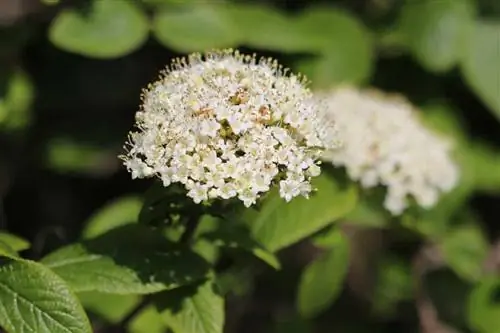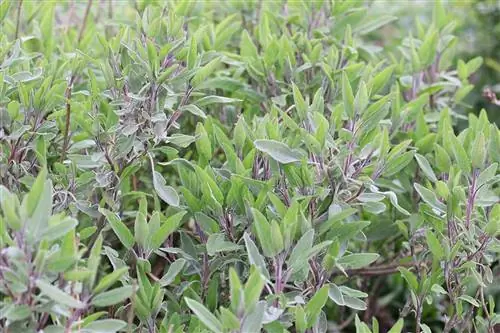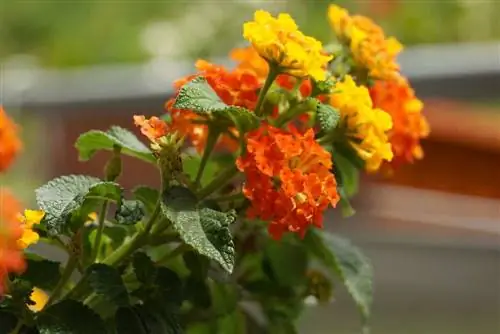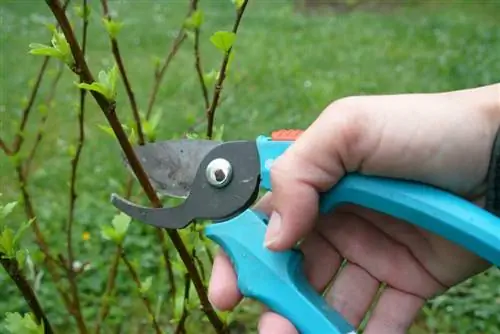- Author admin [email protected].
- Public 2023-12-17 03:39.
- Last modified 2025-01-24 12:45.
The woolly viburnum (Viburnum lantana) is one of the two native wild-growing species of viburnum. A large shrub that grows tightly upright, well branched and, with its dense, bushy growth, is also ideal as a windbreak. The Viburnum lantana is not only an eye-catcher in the garden, because it is also easy to care for and absolutely winter hardy. The snowball thrives in sunny to partially shaded locations in a location protected from the weather and is extremely robust and resistant to diseases and pest infestation.
Growth and flowering
The up to 12 cm long leaves of the woolly snowball are broad and elliptical and are dark green and wrinkled on the upper side, while the underside is adorned with a woolly gray-green. In autumn the foliage turns from green-yellow to vermilion-red. From April to June, the shrub presents its white flowers, which appear in pseudo umbels and are around 6 to 10 cm large. However, the smell of the flowers is perceived very differently - from bad-smelling to pleasantly scented. The red fruits formed in mid-summer after flowering turn black as they ripen (September) and decorate the decorative shrub until winter. Since this process does not occur evenly, the berry stands on the snowball often appear in an attractive play of colors. In addition to its berries, which are attractive to birds, its dense growth also makes a good bird protection tree. In autumn, the deciduous shrub sheds its leaves. Depending on the variety, the snowball reaches a height of 1.50 to 5.00 m.
Substrate
The woolly viburnum thrives in lime-rich and humus-rich garden soils, the pH value ranges from neutral to alkaline (pH value: 5.5 to 8.0). The soil should be moderately fresh to dry, but nutrient-rich. But Viburnum lantana also thrives on stony or pure, calcareous loam and clay soils.
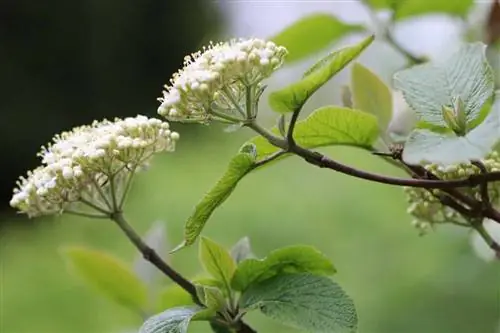
Location
The snowball likes sunny or partially shaded locations. However, it is important to have a protected location, such as that found along walls and in front of hedges. In nature, Viburnum lantana can often be found on sunny forest edges. Since the Viburnum lantana can also tolerate light shading, the shrub is also suitable as an understory in woody stands. Locations that are too humid should be avoided.
Plants
Planting in spring is ideal. The Viburnum lantana can also be planted out in autumn. The strong growth in width requires a large planting distance, which should be at least one meter.
Watering & Fertilizing
The undemanding shrub needs little water and, in normal garden soil, no fertilizer. It likes to stand in fresh, dry soil, although it should be watered during prolonged dry periods.
Cutting
After the flowering period, the lushly growing snowball is cut back or shaped. It blooms even without regular pruning and rejuvenation, but pruning ensures its beautiful growth habit and stimulates the formation of strong new shoots. Once flowering is complete, old wood is removed and irregular shoots are adjusted. Severe pruning generally does not harm the shrub, but it can affect flower formation. The snowball's bark is light gray and ranges from brown in young wood to gray-brown in older specimens. Well-wooded branches are dark brown.
Wintering
Even in winter, the Viburnum lantana does not place any special demands on its care. The winter-hardy snowball planted outdoors does not need winter protection in the cold season. In mild climates, the viburnum can also spend the winter in a pot or bucket, although it is important to avoid the pots freezing.
Propagate
The snowball is propagated via cuttings that are covered with soil and kept slightly moist. After rooting, they are planted out or initially grown in a pot. Another possibility is the formation of sinkers. To do this, the overhanging branches are pressed slightly into the ground and covered with moist soil. Once the sinker has taken root, it can be cut off from the mother plant with a sharp knife. Propagation by dividing the plant is also possible. To do this, the root of the viburnum is cut with a knife so that the plant is divided into two halves.
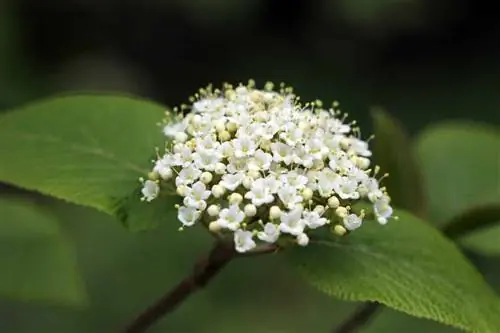
Diseases
The robust snowball is very resistant to diseases, but since it often finds its place on the side of the road, road s alt damages it in winter, which results in spotty leaves.
Pests
Since insects rarely visit the viburnum, which hardly produces any nectar, it is rarely attacked by pests. However, the robust viburnum can be attacked by aphids or caterpillars. Commercially available insecticides against aphids can help.
TheSnowball leaf beetle (Pyrrh alta viburni) causes massive leaf damage to the snowball. The perforated leaves, on which a beetle can hardly survive, can be seen at first glance. In spring, the damage first becomes apparent through so-called “window corrosion,” which later leads to leaves with sieve-like holes. The greenish-yellow, thick larva that the brownish and approximately 0.5 cm long beetle brings with it is responsible. We recommend cutting back shoots covered in eggs and using a commercially available insecticide against larvae.
Frequently asked questions
Does the woolly snowball have to be cut?
Summer green, hardy and easy to care for, the woolly snowball only requires regular topiary - as long as it attracts everyone's attention as a solitary plant.
Is the woolly snowball poisonous?
Viburnum lantana is poisonous to humans and animals (horses), the effect is correspondingly stronger on children. The bark of the viburnum in particular, but also the unripe fruits and leaves, contain toxins (glycosides and viburnin).
What you should know about the woolly snowball soon
The woolly snowball impresses with its white-yellow flowers. The leaves are somewhat tomentose, hairy and wrinkled. The only thing that could stop you from planting the robust ornamental shrub in your garden is its floral scent. On the one hand, this is exotic, but on the other hand, it is probably rather repulsive and unusual for most people. However, the scent is limited to just three months, as this is exactly when the flowers of the woolly viburnum bloom. After flowering, red berries follow, which turn black in autumn.
- The location of the woolly snowball should be either in direct sun or at least in partial shade.
- The soil is ideal if it is particularly rich in lime and nutrients.
- If the location is optimal, the woolly snowball will not only grow in height, but also in width.
- The latter in particular is a reason for many people to get the plant in their garden.
- If you want to plant a woolly viburnum, you should choose the planting time in spring.
- When planting, make sure that the bushes have plenty of space between each other.
- Because the woolly snowball grows very well, the plants are also ideal as protection from unwanted looks.
- The privacy screen then lasts throughout the summer, because in autumn the snowball loses its leaves.
- Cut the viburnum when the flowering period is over. Then you can shape the snowball and it will form strong, new shoots until the next season.
- Even the winter doesn't necessarily affect the plants and you can easily leave them in their location during the cold season.
The only thing that can harm the viburnum are the pests: These include caterpillars and aphids. You should definitely counteract these or at least combat them as quickly as possible, as they can cause enormous damage to the plant. So if you react quickly and boldly in this case, you will certainly be able to enjoy your woolly snowball for many years to come and enjoy it in all its beauty.

